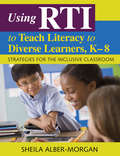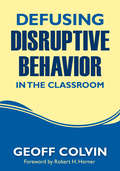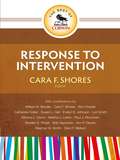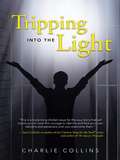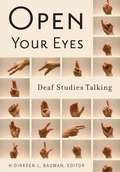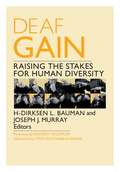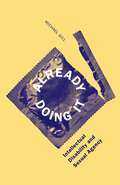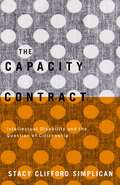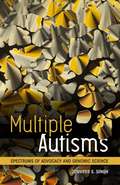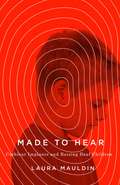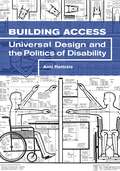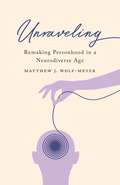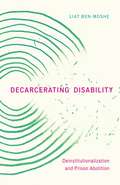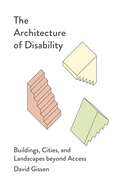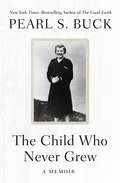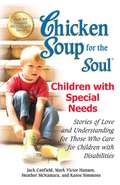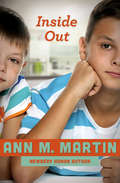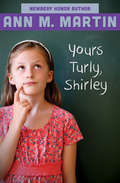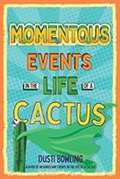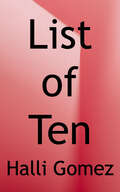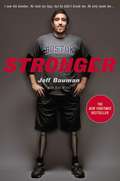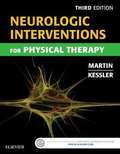- Table View
- List View
Using RTI to Teach Literacy to Diverse Learners, K-8: Strategies for the Inclusive Classroom
by Sheila Alber-MorganPractical intervention strategies for diverse learners who struggle with literacy! Covering reading and writing, this book shows K–8 teachers how to build the literacy skills of diverse learners in inclusive classrooms. The author discusses instruction and assessment within a Response to Intervention (RTI) framework and how to provide targeted support to students who may require special attention. The book offers: Specific literacy intervention strategies for each tier in a 3-tier RTI framework Examples of assessments and graphic organizers Brief case studies illustrating how the strategies can be used with students A discussion on using thematic units to integrate reading and writing
Defusing Disruptive Behavior in the Classroom
by Geoffrey T. ColvinThe ultimate guide to handling problem behavior "in the heat of the moment"! When disruptive behavior occurs, your first response can determine how quickly the situation is resolved. Colvin offers teachers seven key behavioral principles and a range of research-based approaches for immediately defusing disruptive situations, avoiding escalation, and correcting behaviors. This resource features: Strategies that target specific behaviors, including off-task behavior, rule violations, disrespect, agitation, noncompliance, and threats and intimidation Common classroom scenarios and solutions for K–12 general and special education teachers Checklists and action plans for applying the strategies while maintaining the flow of instruction
The Best of Corwin: Response to Intervention
by Cara F. ShoresThe ultimate guide to RTI This resource guides practitioners through the challenging and rewarding process of implementing response to intervention (RTI). The chapters address critical factors such as collecting and using valid and reliable data, choosing from methods that are responsive to individual student needs, and implementing processes with fidelity. The authors describe RTI through various lenses: Behavioral interventions Grade-level approaches from elementary through high school Strategies tailored to English learners Specific content areas, including reading and math Because RTI has the power to help students achieve success in school, this collection a must-have for every educator.
Tripping Into the Light
by Charlie CollinsDiagnosed with a rare eye disorder in the third grade, Charlie's self-esteem began to unravel by the thread. He wouldn't have a future as a detective like his hero, Magnum P. I. He would never soar in a jet fighter like he dreamed. He would never drive a race car and see the checkered flag wave. College was out of the question, because he just wasn't smart enough. At least that's what the teachers told him. Only a God who was unusually cruel would shatter the dreams of a little boy by creating him defective. It was the only explanation that made any sense, and it was a crushing blow. If God didn't care about him, why should he care about himself? And so began Charlie's freefall into a world of negative self-talk and ultimately addiction. A self-destructive plummet that would see him cheat death twice as he marched to the precipice of suicide. Raw and brutally honest, Tripping into the Light is a tale of soaring triumphs and heartbreaking defeat. It illustrates the power of true love and the undying spirit of hope. It is about one man's willingness to try just one more time, when it seemed all was lost. Through Charlie's eyes, we see that all things are possible if we are willing to roll up our sleeves and do the work. www. TrippingIntoTheLight. com
Open Your Eyes
by H-Dirksen L. BaumanThis groundbreaking volume introduces readers to the key concepts and debates in deaf studies, offering perspectives on the relevance and richness of deaf ways of being in the world. In Open Your Eyes, leading and emerging scholars, the majority of whom are deaf, consider physical and cultural boundaries of deaf places and probe the complex intersections of deaf identities with gender, sexuality, disability, family, and race. Together, they explore the role of sensory perception in constructing community, redefine literacy in light of signed languages, and delve into the profound medical, social, and political dimensions of the disability label often assigned to deafness.Moving beyond proving the existence of deaf culture, Open Your Eyes shows how the culture contributes vital insights on issues of identity, language, and power, and, ultimately, challenges our culture's obsession with normalcy. Contributors: Benjamin Bahan, Gallaudet U; Douglas C. Baynton, U of Iowa; Frank Bechter, U of Chicago; MJ Bienvenu, Gallaudet U; Brenda Jo Brueggemann, Ohio State U; Lennard J. Davis, U of Illinois, Chicago; Lindsay Dunn, Gallaudet U; Lawrence Fleischer, California State U, Northridge; Genie Gertz, California State U, Northridge; Hilde Haualand, FAFO Institute; Robert Hoffmeister, Boston U; Tom Humphries, U of California, San Diego; Arlene Blumenthal Kelly, Gallaudet U; Marlon Kuntze, U of California, Berkeley; Paddy Ladd, U of Bristol; Harlan Lane, Northeastern U; Joseph J. Murray, U of Iowa; Carol Padden, U of California, San Diego.
Deaf Gain
by Joseph J. Murray H-Dirksen L. BaumanDeaf people are usually regarded by the hearing world as having a lack, as missing a sense. Yet a definition of deaf people based on hearing loss obscures a wealth of ways in which societies have benefited from the significant contributions of deaf people. In this bold intervention into ongoing debates about disability and what it means to be human, experts from a variety of disciplines--neuroscience, linguistics, bioethics, history, cultural studies, education, public policy, art, and architecture--advance the concept of Deaf Gain and challenge assumptions about what is normal.Through their in-depth articulation of Deaf Gain, the editors and authors of this pathbreaking volume approach deafness as a distinct way of being in the world, one which opens up perceptions, perspectives, and insights that are less common to the majority of hearing persons. For example, deaf individuals tend to have unique capabilities in spatial and facial recognition, peripheral processing, and the detection of images. And users of sign language, which neuroscientists have shown to be biologically equivalent to speech, contribute toward a robust range of creative expression and understanding. By framing deafness in terms of its intellectual, creative, and cultural benefits, Deaf Gain recognizes physical and cognitive difference as a vital aspect of human diversity.Contributors: David Armstrong; Benjamin Bahan, Gallaudet U; Hansel Bauman, Gallaudet U; John D. Bonvillian, U of Virginia; Alison Bryan; Teresa Blankmeyer Burke, Gallaudet U; Cindee Calton; Debra Cole; Matthew Dye, U of Illinois at Urbana-Champaign; Steve Emery; Ofelia García, CUNY; Peter C. Hauser, Rochester Institute of Technology; Geo Kartheiser; Caroline Kobek Pezzarossi; Christopher Krentz, U of Virginia; Annelies Kusters; Irene W. Leigh, Gallaudet U; Elizabeth M. Lockwood, U of Arizona; Summer Loeffler; Mara Lúcia Massuti, Instituto Federal de Santa Catarina, Brazil; Donna A. Morere, Gallaudet U; Kati Morton; Ronice Müller de Quadros, U Federal de Santa Catarina, Brazil; Donna Jo Napoli, Swarthmore College; Jennifer Nelson, Gallaudet U; Laura-Ann Petitto, Gallaudet U; Suvi Pylvänen, Kymenlaakso U of Applied Sciences; Antti Raike, Aalto U; Päivi Rainò, U of Applied Sciences Humak; Katherine D. Rogers; Clara Sherley-Appel; Kristin Snoddon, U of Alberta; Karin Strobel, U Federal de Santa Catarina, Brazil; Hilary Sutherland; Rachel Sutton-Spence, U of Bristol, England; James Tabery, U of Utah; Jennifer Grinder Witteborg; Mark Zaurov.
Already Doing It
by Michael GillWhy is the sexuality of people with intellectual disabilities often deemed "risky" or "inappropriate" by teachers, parents, support staff, medical professionals, judges, and the media? Should sexual citizenship depend on IQ? Confronting such questions head-on, Already Doing It exposes the "sexual ableism" that denies the reality of individuals who, despite the restrictions they face, actively make decisions about their sexual lives.Tracing the history of efforts in the United States to limit the sexual freedoms of such persons using methods such as forced sterilization, invasive birth control, and gender-segregated living arrangements--Michael Gill demonstrates that these widespread practices stemmed from dominant views of disabled sexuality, not least the notion that intellectually disabled women are excessively sexual and fertile while their male counterparts are sexually predatory. Analyzing legal discourses, sex education materials, and news stories going back to the 1970s, he shows, for example, that the intense focus on "stranger danger" in sex education for intellectually disabled individuals disregards their ability to independently choose activities and sexual partners--including nonheterosexual ones, who are frequently treated with heightened suspicion. He also examines ethical issues surrounding masturbation training that aims to regulate individuals' sexual lives, challenges the perception that those whose sexuality is controlled (or rejected) should not reproduce, and proposes recognition of the right to become parents for adults with intellectual disabilities. A powerfully argued call for sexual and reproductive justice for people with intellectual disabilities, Already Doing It urges a shift away from the compulsion to manage "deviance" (better known today as harm reduction) because the right to pleasure and intellectual disability are not mutually exclusive. In so doing, it represents a vital new contribution to the ongoing debate over who, in the United States, should be allowed to have sex, reproduce, marry, and raise children.
The Capacity Contract
by Stacy Clifford SimplicanIn the first sustained examination of disability through the lens of political theory, The Capacity Contract shows how the exclusion of disabled people has shaped democratic politics. Stacy Clifford Simplican demonstrates how disability buttresses systems of domination based on race, sex, and gender. She exposes how democratic theory and politics have long blocked from political citizenship anyone whose cognitive capacity falls below a threshold level marginalization with real-world repercussions on the implementation of disability rights today. Simplican's compelling ethnographic analysis of the self-advocacy movement describes the obstacles it faces. From the outside, the movement must confront stiff budget cuts and dwindling memberships; internally, self-advocates must find ways to demand political standing without reinforcing entrenched stigma against people with profound cognitive disabilities. And yet Simplican's investigation also offers democratic theorists and disability activists a more emancipatory vision of democracy as it relates to disability one that focuses on enabling people to engage in public and spontaneous action to disrupt exclusion and stigma. Taking seriously democratic promises of equality and inclusion, The Capacity Contract rejects conceptions of political citizenship that privilege cognitive capacity and, instead, centers such citizenship on action that is accessible to all people.
Multiple Autisms: Spectrums of Advocacy and Genomic Science
by Jennifer S. SinghIs there a gene for autism? Despite a billion-dollar, twenty-year effort to find out--and the more elusive the answer, the greater the search seems to become--no single autism gene has been identified. In Multiple Autisms, Jennifer S. Singh sets out to discover how autism emerged as a genetic disorder and how this affects those who study autism and those who live with it. This is the first sustained analysis of the practices, politics, and meaning of autism genetics from a scientific, cultural, and social perspective.In 2004, when Singh began her research, the prevalence of autism was reported as 1 in 150 children. Ten years later, the number had jumped to 1 in 100, with the disorder five times more common in boys than in girls. Meanwhile the diagnosis changed to "autistic spectrum disorders," and investigations began to focus more on genomics than genetics, less on single genes than on hundreds of interacting genes. Multiple Autisms charts this shift and its consequences through nine years of ethnographic observations, analysis of scientific and related literatures, and morethan seventy interviews with autism scientists, parents of children with autism, and people on the autism spectrum. The book maps out the social history of parental activism in autism genetics, the scientific optimism about finding a gene for autism and the subsequent failure, and the cost in personal and social terms of viewing and translating autism through a genomic lens.How is genetic information useful to people living with autism? By considering this question alongside the scientific and social issues that autism research raises, Singh's work shows us the true reach and implications of a genomic gaze.
Made to Hear: Cochlear Implants and Raising Deaf Children
by Laura MauldinA mother whose child has had a cochlear implant tells Laura Mauldin why enrollment in the sign language program at her daughter's school is plummeting: "The majority of parents want their kids to talk." Some parents, however, feel very differently, because "curing" deafness with cochlear implants is uncertain, difficult, and freighted with judgment about what is normal, acceptable, and right. Made to Hear sensitively and thoroughly considers the structure and culture of the systems we have built to make deaf children hear.Based on accounts of and interviews with families who adopt the cochlear implant for their deaf children, this book describes the experiences of mothers as they navigate the health care system, their interactions with the professionals who work with them, and the influence of neuroscience on the process. Though Mauldin explains the politics surrounding the issue, her focus is not on the controversy of whether to have a cochlear implant but on the long-term, multiyear undertaking of implantation. Her study provides a nuanced view of a social context in which science, technology, and medicine are trusted to vanquish disability--and in which mothers are expected to use these tools. Made to Hear reveals that implantation has the central goal of controlling the development of the deaf child's brain by boosting synapses for spoken language and inhibiting those for sign language, placing the politics of neuroscience front and center.Examining the consequences of cochlear implant technology for professionals and parents of deaf children, Made to Hear shows how certain neuroscientific claims about neuroplasticity, deafness, and language are deployed to encourage compliance with medical technology.
Building Access: Universal Design and the Politics of Disability
by Aimi Hamraie“All too often,” wrote disabled architect Ronald Mace, “designers don’t take the needs of disabled and elderly people into account.” Building Access investigates twentieth-century strategies for designing the world with disability in mind. Commonly understood in terms of curb cuts, automatic doors, Braille signs, and flexible kitchens, Universal Design purported to create a built environment for everyone, not only the average citizen. But who counts as “everyone,” Aimi Hamraie asks, and how can designers know? Blending technoscience studies and design history with critical disability, race, and feminist theories, Building Access interrogates the historical, cultural, and theoretical contexts for these questions, offering a groundbreaking critical history of Universal Design. Hamraie reveals that the twentieth-century shift from “design for the average” to “design for all” took place through liberal political, economic, and scientific structures concerned with defining the disabled user and designing in its name. Tracing the co-evolution of accessible design for disabled veterans, a radical disability maker movement, disability rights law, and strategies for diversifying the architecture profession, Hamraie shows that Universal Design was not just an approach to creating new products or spaces, but also a sustained, understated activist movement challenging dominant understandings of disability in architecture, medicine, and society.Illustrated with a wealth of rare archival materials, Building Access brings together scientific, social, and political histories in what is not only the pioneering critical account of Universal Design but also a deep engagement with the politics of knowing, making, and belonging in twentieth-century United States.
Unraveling: Remaking Personhood in a Neurodiverse Age
by Matthew J. Wolf-MeyerDeveloping a cybernetic model of subjectivity and personhood that honors disability experiences to reconceptualize the category of the human Twentieth-century neuroscience fixed the brain as the basis of consciousness, the self, identity, individuality, even life itself, obscuring the fundamental relationships between bodies and the worlds that they inhabit. In Unraveling, Matthew J. Wolf-Meyer draws on narratives of family and individual experiences with neurological disorders, paired with texts by neuroscientists and psychiatrists, to decenter the brain and expose the ableist biases in the dominant thinking about personhood. Unraveling articulates a novel cybernetic theory of subjectivity in which the nervous system is connected to the world it inhabits rather than being walled off inside the body, moving beyond neuroscientific, symbolic, and materialist approaches to the self to focus instead on such concepts as animation, modularity, and facilitation. It does so through close readings of memoirs by individuals who lost their hearing or developed trauma-induced aphasia, as well as family members of people diagnosed as autistic—texts that rethink modes of subjectivity through experiences with communication, caregiving, and the demands of everyday life. Arguing for a radical antinormative bioethics, Unraveling shifts the discourse on neurological disorders from such value-laden concepts as &“quality of life&” to develop an inclusive model of personhood that honors disability experiences and reconceptualizes the category of the human in all of its social, technological, and environmental contexts.
Decarcerating Disability: Deinstitutionalization and Prison Abolition
by Liat Ben-MosheThis vital addition to carceral, prison, and disability studies draws important new links between deinstitutionalization and decarceration Prison abolition and decarceration are increasingly debated, but it is often without taking into account the largest exodus of people from carceral facilities in the twentieth century: the closure of disability institutions and psychiatric hospitals. Decarcerating Disability provides a much-needed corrective, combining a genealogy of deinstitutionalization with critiques of the current prison system.Liat Ben-Moshe provides groundbreaking case studies that show how abolition is not an unattainable goal but rather a reality, and how it plays out in different arenas of incarceration—antipsychiatry, the field of intellectual disabilities, and the fight against the prison-industrial complex. Ben-Moshe discusses a range of topics, including why deinstitutionalization is often wrongly blamed for the rise in incarceration; who resists decarceration and deinstitutionalization, and the coalitions opposing such resistance; and how understanding deinstitutionalization as a form of residential integration makes visible intersections with racial desegregation. By connecting deinstitutionalization with prison abolition, Decarcerating Disability also illuminates some of the limitations of disability rights and inclusion discourses, as well as tactics such as litigation, in securing freedom. Decarcerating Disability&’s rich analysis of lived experience, history, and culture helps to chart a way out of a failing system of incarceration.
The Architecture of Disability: Buildings, Cities, and Landscapes beyond Access
by David GissenA radical critique of architecture that places disability at the heart of the built environment Disability critiques of architecture usually emphasize the need for modification and increased access, but The Architecture of Disability calls for a radical reorientation of this perspective by situating experiences of impairment as a new foundation for the built environment. With its provocative proposal for &“the construction of disability,&” this book fundamentally reconsiders how we conceive of and experience disability in our world. Stressing the connection between architectural form and the capacities of the human body, David Gissen demonstrates how disability haunts the history and practice of architecture. Examining various historic sites, landscape designs, and urban spaces, he deconstructs the prevailing functionalist approach to accommodating disabled people in architecture and instead asserts that physical capacity is essential to the conception of all designed space. By recontextualizing the history of architecture through the discourse of disability, The Architecture of Disability presents a unique challenge to current modes of architectural practice, theory, and education. Envisioning an architectural design that fully integrates disabled persons into its production, it advocates for looking beyond traditional notions of accessibility and shows how certain incapacities can offer us the means to positively reimagine the roots of architecture.
The Child Who Never Grew: A Memoir
by Pearl S. BuckA &“groundbreaking&” memoir about raising a special-needs daughter in an era of misinformation and prejudice—a classic that helped transform our perceptions (Publishers Weekly). It was my child who taught me to understand so clearly that all people are equal in their humanity and that all have the same human rights. Pearl S. Buck is known today for earning a Nobel Prize in Literature and for such New York Times–bestselling novels as The Good Earth. What many do not know is that she wrote that great work of art with the motivation of paying for a special school for her oldest daughter, Carol, who had a rare developmental disorder. What was called &“mental retardation&” at the time—though some used crueler terms—was a disability that could cause great suffering and break a parent&’s heart. There was little awareness of how to deal with such children, and as a result some were simply hidden away, considered a source of shame and stigma, while others were taken advantage of because of their innocence. In this remarkable account, which helped bring the issue to light, Pearl S. Buck candidly discusses her own experience as a mother, from her struggle to accept Carol&’s diagnosis to her determination to give her child as full and happy a life as possible, including a top-quality education designed around her needs and abilities. Both heartrending and inspiring, The Child Who Never Grew provides perspective on just how much progress has been made in recent decades, while also offering common sense and timeless wisdom for the challenges still faced by those who love and care for someone with special needs. It is a clear-eyed and compelling read by a woman renowned for both her literary talent and her humanitarian spirit. This ebook features an illustrated biography of Pearl S. Buck including rare images from the author&’s estate.
Chicken Soup for the Soul Children with Special Needs
by Jack Canfield Mark Victor Hansen Heather Mcnamara Karen SimmonsRaising a child with special needs is a lifelong commitment that is as unique as each person who embarks on it. Written by a variety of authors who share in this distinctive relationship, Chicken Soup for the Soul Children with Special Needs offers a glimpse into the lives of others who are on a similar path. These stories provide insight, comfort, and connection with others who have walked this powerful and transformational journey. The authors of these candid stories relate their own experiences of adjusting, reaching out, and flourishing and share their universal worries, their tears, and the laughter that come with this extraordinary relationship. Most important, through these stories, you will be guided with the wisdom of fellow parents, caregivers, and those with special needs to help you be the very best parent or caregiver you can be.
Chicken Soup for the Soul Children with Special Needs: Stories of Love and Understanding for Those Who Care for Children with Disabilities
by Jack Canfield Mark Victor Hansen Heather Mcnamara Karen SimmonsRaising a child with special needs is a lifelong commitment that is as unique as each person who embarks on it. Written by a variety of authors who share in this distinctive relationship, Chicken Soup for the Soul Children with Special Needs offers a glimpse into the lives of others who are on a similar path. These stories provide insight, comfort, and connection with others who have walked this powerful and transformational journey. The authors of these candid stories relate their own experiences of adjusting, reaching out, and flourishing and share their universal worries, their tears, and the laughter that come with this extraordinary relationship. Most important, through these stories, you will be guided with the wisdom of fellow parents, caregivers, and those with special needs to help you be the very best parent or caregiver you can be.
Inside Out
by Ann M. MartinHow do you love someone who makes you miserable? Eleven-year-old Jonathan just wants to have a normal life—for instance, a night when he isn&’t awakened by screams, or a day when he&’s not teased by other kids for having a disabled family member. But normal can&’t happen when your little brother is severely autistic.James, Jonathan&’s four-year-old brother, needs more help than his parents can give him. And it&’s not just hard for Jonathan—it&’s causing strife for the whole family. When James gets into a special school for autistic children, Jonathan and his sister have to make a lot of sacrifices so he can go. Jonathan comes up with an idea to help out the family—but will his plan work, or only lead to more teasing?This ebook features an illustrated personal history of Ann M. Martin, including rare images from the author&’s collection.
Yours Turly, Shirley
by Ann M. MartinSurviving fourth grade isn&’t going to be easy for Shirley—but the thought of repeating it with her younger sister is too much to bearShirley Basini is dreading fourth grade—if she doesn&’t do well this year, she&’ll be held back. Having dyslexia is tough, but having a brilliant older brother makes it even worse. When Shirley&’s parents adopt a young girl from Vietnam, she&’s excited to have someone whom, for once, she can teach some things.But her new sister is actually quite adept at English and winds up in the advanced third-grade class. Shirley can&’t face the prospect of repeating fourth grade—this time with her adopted sister, who might even perform better than she does. Shirley has only one talent that might prove she&’s not dumb—but does she have the will to let it shine?This ebook features an illustrated personal history of Ann M. Martin, including rare images from the author&’s collection.
The Unstoppable Kitty Madison
by Tracy Lee Fitch"Hello world, it´s me, Kitty Madison. I may be blind, but nothing is going to stop me!" Kitty is confident that she can do anything and doesn't want anyone to feel sorry for her. Then, one day she finds out that she has been chosen to speak at the National Association of the Blind's national convention. How can she possibly speak for her entire generation of kids who are blind? Suddenly, she feels unsure of herself and afraid of the possible outcome. Is she really as unstoppable as she has always believed or will she find the strength and courage to speak from the heart?
A Great Place for a Seizure
by Terry TracyMischa Dunn's family flees Chile in the wake of the 1973 coup d'etat that installs a military dictatorship. She settles comfortably in her newly adopted country, the United States, until one day, an unexplained seizure in a library signals the beginning of her life with epilepsy. With an engaging balance of humor, insight, and sensitivity Mischa draws the reader into a vivid tale that travels across three continents over thirty years.
Momentous Events in the Life of a Cactus (Life Of A Cactus #2)
by Dusti BowlingJust as Aven starts to feel comfortable in Stagecoach Pass, with her friends and schoolmates accustomed to her lack of "armage," everything changes once again. She's about to begin high school with 3,000 new kids to stare at her. And no matter how much Aven tries to play it cool, nothing prepares her for the reality.
List of Ten
by Halli GomezIt's Kind of a Funny Story meets Turtles All the Way Down in this harrowing yet hopeful account of a teen living with Tourette syndrome and obsessive-compulsive disorder while contemplating his own mortality. <p><p>Ten: three little letters, one ordinary number. For Troy Hayes, a 16-year-old suffering from Tourette syndrome and obsessive-compulsive disorder, the number ten dictates his life, forcing him to do everything by its exacting rhythm. Fed up with the humiliation, loneliness, and physical pain, Troy creates a list of ten things to do by the tenth anniversary of his diagnosis--culminating in suicide. <p><p>But the process of working his way through the list changes Troy. He becomes friends with Khory, who unwittingly helps Troy cross off items on his list, even as she shows him that life may have more possibilities than he imagined.
Stronger
by Jeff Bauman Bret WitterWhen Jeff Bauman woke up on Tuesday, April 16th, 2013 in the Boston Medical Center, groggy from a series of lifesaving surgeries and missing his legs, the first thing he did was try to speak. When he realized he couldn't, he asked for a pad and paper and wrote down seven words: "Saw the guy. Looked right at me," setting off one of the biggest manhunts in the country's history. Just thirty hours before, Jeff had been at the finish line of the 2013 Boston Marathon cheering on his girlfriend, Erin, when the first bomb went off at his feet. As he was rushed to the hospital, he realized he was severely injured and that he might die, but he didn't know that a photograph of him in a wheelchair was circulating throughout the world, making him the human face of the Boston Marathon bombing victims, or that what he'd seen would give the Boston police their most important breakthrough. Up until the marathon, Jeff had been a normal 27-year-old guy, looking forward to moving in with Erin and starting the next phase of their lives together. But when his life was turned upside down in ways he could never have fathomed, Jeff did not give up. Instead he faced his new circumstances with grace, humor, and a sense of purpose: he was determined, no matter what, to walk again. In STRONGER, Jeff describes the chaos and terror of the bombing itself and the ongoing FBI investigation in which he was a key witness. He takes us inside his grueling rehabilitation, and discusses his attempt to reconcile the world's admiration with his own guilt and frustration. And he tells of the courage of his fellow survivors. Brave, compassionate, and emotionally compelling, Jeff Bauman's story is not just his, but ours as well. It proves that the terrorists accomplished nothing with their act of cowardice and shows the entire world what Boston Strong really means.
Neurologic Interventions for Physical Therapy
by Suzanne Tink" Martin Mary KesslerMaster the role of the physical therapist or physical therapist assistant in neurologic rehabilitation! Neurologic Interventions for Physical Therapy, 3rd Edition helps you develop skills in the treatment interventions needed to improve the function of patients with neurologic deficits. It provides a solid foundation in neuroanatomy, motor control, and motor development, and offers clear, how-to guidelines to rehabilitation procedures. Case studies help you follow best practices for the treatment of children and adults with neuromuscular impairments caused by events such as spinal cord injuries, cerebral palsy, and traumatic brain injuries. Written by physical therapy experts Suzanne 'Tink' Martin and Mary Kessler, this market-leading text will help you prepare for the neurological portion of the PTA certification exam and begin a successful career in physical therapy practice. Comprehensive coverage of neurologic rehabilitation explores concepts in neuroanatomy, motor control and motor learning, motor development, and evidence-based treatment of adults and children with neuromuscular impairments.
